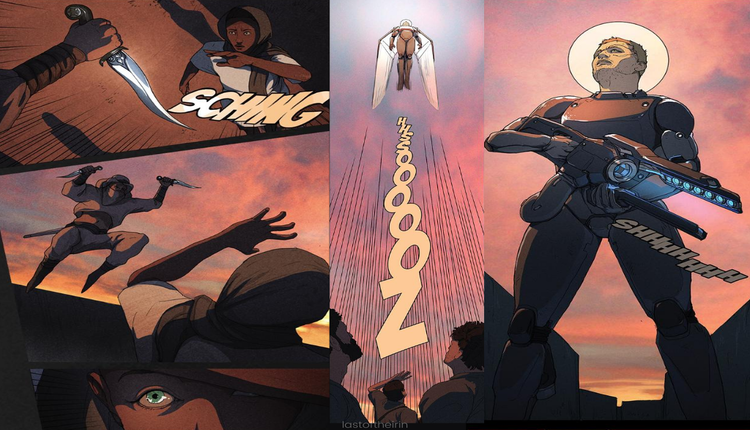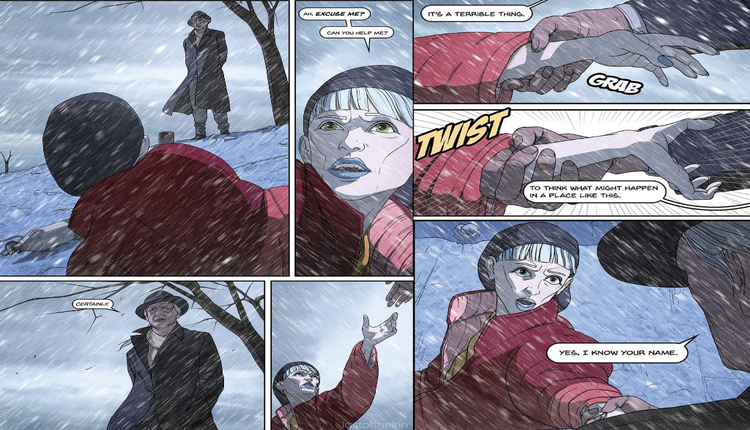Book Review | The Last of the Irin: Volume One is an Ambitious Take on Ancient Aliens
The belief that humankind was created and fostered through our early years by extra-terrestrials is not an uncommon one. Though mostly dismissed as a myth and conspiracy theory it’s hard not to look at the Egyptian or Mayan pyramids or the Nazca Lines in Peru and see them as either the work of Gods or of the Gods acting through humanity. Robert McMillan’s three volume graphic novel The Last of the Irin makes the case that aliens in the guise of our Gods have been meddling in human development since Creation itself.
Beginning in 591 BC the first sons of El – King of the Sirusian alien race – Baal and Yahweh are at each other’s throats. Angered by Baal’s exclusion of him and his treatment of the Jewish people, Yahweh’s own creation, Yahweh infects Baal’s son Marduk, administrator of Earth, with smallpox. Yahweh, his descendants and staff are exiled to the abandoned mining planet Caspius. Some two-and-a-half-thousand years later Satan – former guard to Marduk – is left in charge of a quarantined Earth. Meanwhile Anahita, Satan’s daughter by a human woman, is dying of cancer and the old Sirusian takes pity on the girl. Back on Caspius Yahweh’s son Wariq dreams of escaping and when an opportunity to get back to his father’s favoured planet arises he seizes it with both hands.
A pantheon of Gods, fictional or not, can be hard to corral into a relatively linear narrative and they can often make things that were already complicated even more so. The story of the Battle of Troy for instance is already a complex tale without adding in the numerous Gods on either side of the ten year siege. But without them we wouldn’t have Homer’s Iliad, Odyssey or Aeneid. It bears mentioning that upon first reading, even with the occasional footnote, The Last of the Irin can be a little overwhelming. The graphic novel comes with its own codex which offers notes on characters like Baal and Yahweh as well as explanations on railgun technology and ancient Canaanite rituals. Needless to say The Last of the Irin is neither as long nor as dated as any of Homer’s great epics but it feels just as ambitious and its cast of roguish characters breathe life into its ambitious story and detailed world.

There have been plenty of interpretations of Satan over the last few decades – hardboiled detective, Saddam Hussein’s lover, Robert De Niro with long hair – but space marine is a new one. Initially a guard to Marduk he rises through the ranks after Baal’s firstborn dies and becomes the Sirusian in charge of keeping Earth sequestered from the rest of the galaxy. What his fellow Sirusians see as a punishment detail Satan sees as an opportunity to rule over his own private domain. In a message to his daughter Anahita he says “I am the devil they claim me to be”. Although he does a kindness in saving his daughter it’s soon clear that this is just one step in his plan to disrupt the rule of the empire that began on the distant planet Soma that orbits the star Sirus.
Anahita isn’t the only one that figures into Satan’s as yet unknown plans but she is the most prominent. Over the course of Volume One the terminally ill girl grows from a wheelchair-bound cancer patient to a frighteningly resourceful go-getter. McMillan’s art style and writing emphasize this growth especially well. Thanks to Satan’s treatments Anahita becomes fitter and stronger as her face fills out and her posture changes from defeated to confident. Dialogue suggests that this version of Anahita was just waiting to come back out as nearly every sentence out of her mouth is a snappy reply or sarcastic comment. McMillan’s line work, especially evident in the faces of his characters, expresses everything the minimalist dialogue does not.
What can’t be expressed by the lines and planes of a character’s face or in dialogue is done through background and action instead. Solid colours make up the backgrounds of most panels and sound effects like the “SPLAT” of a hollowed out head hitting the floor are mercifully rare. Religious and sci-fi imagery are blended easily together as Satan’s space helmet glows in the light of the dying sun like a halo in a stained glass window. It’s these small details like the wings on the space suits and Baal’s grotesquely horned and wart spotted head that render the ancient alien gods theme believable in the context of the story. It helps that these details really pop too coloured as they are in pale sunny yellows, twilight blues and salmon pinks.

It can often be said that the details a graphic novel chooses to emphasize are of a sexually explicit or violent nature. It’s especially obvious – looking at you, Kick-Ass – when a graphic novel chooses to use these details as a crutch rather than a tool. That’s not to say that The Last of the Irin doesn’t have the goods, it does, but it uses them sparingly at least in Volume One. Still, what is there matches the detail of McMillan’s more story and character focused scenes. The effect of a railgun projectile on a human head is drawn in all its gory detail and along with the sexual slavery Baal imposes on the people of Canaan it illustrates the cruelty of the human race’s supposed benefactors.
The Last of the Irin can initially be hard to get into. Few texts so obsessed with the origins of the Abrahamic religions are easy to read. Although its scale is far from biblical it doesn’t lack for ambition and that’s what makes it easy to admire. It’s detailed world and absorbing story open up through its characters and although Wariq definitely needs more development beyond skirt chasing prodigal son the resourceful Anahita and her enigmatic father make up for this. Volume One’s 98 pages are a promising start to a trilogy that seems to be aiming for the stars and if it’s trajectory is right it might just land among them.
Further Reading: Graphic Novels Matter | Discovering Graphic Novels for Adults.
Featured Image Courtesy of Publisher.
A preview of The Last of Irin along with its accompanying codex can be found here.

